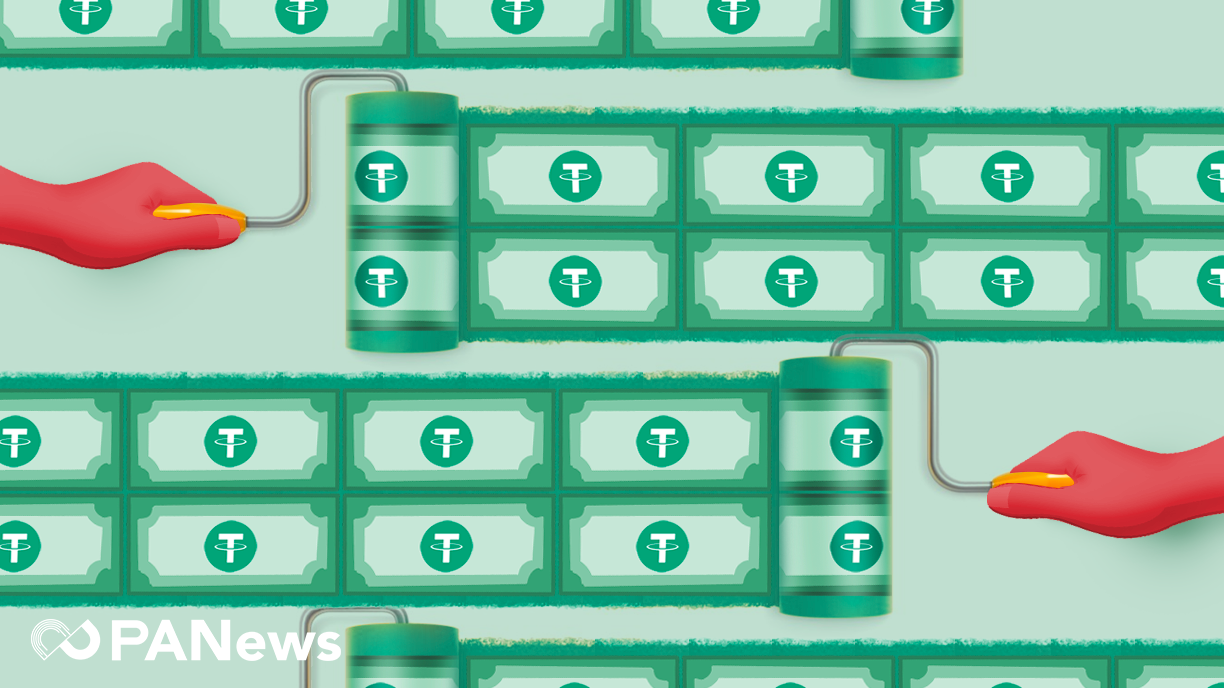Three "printing machines" are open: this year, USDT has accumulated more than 1 billion yuan to renew the stable currency market.

Since April, according to blockchain data and security service provider PeckShield, the largest stable currency issuer, Tether, has accumulated “printing and issuing additional shares” on Omni, ERC20 and TRC20 for 10 times, with a total amount of US$745.9 million. The total market capitalization of various USDTs exceeds US$3 billion [1]. Tether's move has greatly strengthened USDT's position as the "leading boss" in the stable currency market.
The issue of stable currency should have been “regular operation”, but the biggest thing about the series of additional issuances this month is that Tether is no longer the same as “transferring additional issuances” in the past, just turning USDT from Tether Treasury. Out, the 10 additional issuances this month are all "printing of additional banknotes", that is, "printing money" is actually on the three public chains. If you count the cumulative total of 329.5 million “transfers and additional issuances” that Tether has completed on the Bitcoin Omni agreement this year, the total total increase in Tether has exceeded $1,075.9 million since January this year. At the same time, Bitfinex's suspicion of stealing Tether funds to fill the hole is still fermenting, which makes Tether's additional hair look more like an "empty glove white wolf" action.
PAData tried to use the data to restore this series of grants to observe changes in the stable currency market.
- Samsung executives responded to the rumor of the currency: most likely the development of the electronics department, but ultimately depends on the use case
- Building a city of wisdom on the blockchain | 2050 Conference·New Life Forum
- The history of password punk is the history of growth after 90, is the spirit of password punk lost?
"Printing money" has a high frequency, a large amount, and a wide platform
According to the monitoring of PeckShield's dynamic sensing platform, USDT has completed “printing additional issuances” 10 times since April [2], which is equivalent to printing one banknote every three days. Among them, the USDT (hereinafter referred to as ERC20 USDT) based on the Ethereum ERC20 smart contract has the most frequent number of “printing of banknotes”, a total of 6 times. Secondly, based on the TRON wave field TRC20 USDT (hereinafter referred to as TRC20 USDT), a total of "printing additional issued" three times. The least number of “printing outsends” was based on the Bitcoin Omni-based USDT (hereinafter referred to as Omni USDT), and the only one occurred on the 24th of this month, which was transferred from Tether's banknote address to Tether Treasury.
In addition, according to the change in the balance of Tether Treasury, on January 1 this year, its balance was 624.4 million US dollars, and on April 27, the balance was 294.8 million US dollars, equivalent to Tether's "transfer and issue" to the market of 32.95 million US dollars. Jeff, head of the PeckShield Silicon Valley R&D Center, told PANews that “Tether Treasury’s balance was only around 150 million a few days before the 'printing of the banknotes’, indicating that demand for USDT has risen with the market warming this year, before Tether Always transferred from the 'depot' (Tether Treasury) to the USDT, releasing liquidity, but as the balance became less and less, Tether began to print money. The 300 million printed on the 24th part of the replenishment of the 'depot', and part of it Has turned to the circulation market."
Therefore, from the total amount of additional issuance, this year, Omni USDT has issued a total of about 630 million US dollars, ERC20 USDT has issued a total of 340 million US dollars, TRC20 USDT has issued more than 100 million US dollars. The total amount of the three types of USDT cumulative is more than 1.07 billion US dollars, this data is close to 64.8% of the total number of USDT increase in the first 11 months of 2018 [3].

After a series of additional issuances this month, although the ERC20 USDT has the largest number of additional issuances and the largest increase, the Omni USDT is still the main type of USDT, with a total market circulation of more than 2.5 billion US dollars, accounting for about three types of USDT total liquidity. 83%. After 6 additional issuances of ERC20 USDT, the market liquidity has increased from about 60 million US dollars at the beginning of the year (2019/01/01) to more than 400 million US dollars at present, an astonishing 567% increase. At present, its market circulation accounts for about 57%. 13% of the total flow of the three types of USDT is currently the mainstream stable currency after Omini USDT. Just on April 9th, the TRC20 USDT officially issued on April 17 has reached 106.4 million US dollars in less than one month, accounting for 4% of the total flow of the three types of USDT. The least amount of one type.
However, the market liquidity of TRC20 USDT around US$100 million is already higher than the DAI that is in the forefront of the DeFi concept, and is higher than GUSD, EURS, nUSD and DGX, which is second only to Omni USDT, ERC20 USDT, USDC, TUSD and The sixth major stable currency after PAX.
“The Omni public chain has long since given up maintenance, supporting very few wallets, slow and expensive transfers, lack of scalability and infrastructure, as well as Ethereum, support for exchanges is very small, transfer is also slow and expensive.” TRON founder Sun Yuchen Mars Finance said that the ETF20 version of the Ethereum's USDT was issued by Tether and the two parties did not reach a cooperation.
USDT's total market share has risen by more than 80% after the crazy "printing"
PAData's earlier report on "2018 Stable Dollar Year: Quantitative Analysis of Liquidity and Stability" mentioned the share of USDT in the mainstream stable currency market before September 2018 (referred to as "market share"). It has been stable at more than 95%, but after the “trust crisis” on October 15 last year, the market share of USDT has been falling all the way. By the end of November last year, its market share has dropped to around 75% (including Omni USDT and ERC20 USDT).
This form has not been reversed until January of this year. According to PeckShield's monitoring, on January 1 this year, USDT (including Omni USDT and ERC20 USDT) had a market share of approximately 70%, continuing the downward trend since last 10 years. On the contrary, USDC's market share of transaction mining activities launched by the BitMax exchange has soared, and the market share has once risen to 9.52%. TUSD, GUSD and DAI also divided the market for USDT losses. As of January 1 this year, the market share reached 7.49%, 3.33% and 2.52%, respectively, both of which were higher than the end of November 2018.

Although USDT has occupied the absolute leading position of the mainstream stable currency market from beginning to end, other emerging stable currencies have developed strongly and continue to exert pressure on the dominant position of USDT. However, this trend has been broken after the USDT issuance.
After the 10th additional issuance of USDT this month, Omni USDT, ERC20 USDT and TRC20 USDT currently account for 66.72%, 10.57% and 2.81% of the total circulating currency market circulation, respectively. The total market share of USDT has exceeded 80%, up about 5 percentage points from November last year. On the other hand, other stable currencies, without exception, all market share declined, USDC fell from 9.52% to 6.80%, TUSD fell from 7.49% to 5.42%, PAX fell from 51.15 to 3.00%, and the recent hot DAI also came from 2.52%. Dropped to 2.28%. It can be said that USDT has re-consolidated its status as a “stable coin leader” through a series of additional issuances.
Introducing the public chain of stable currency needs to be alert to the chain reaction of the stable currency trust crisis
In March of this year, the wave field announced that it had reached a cooperation with Tether, and USDT will issue the “wavefield custom model” TRC20 USDT. This move seems to have opened a slogan. On the one hand, the public chain dedicated to ecological construction has seen and stabilized the currency issue. The importance of a company alliance. Sun Yuchen once told the media that the introduction of stable coins can increase liquidity for decentralized exchanges, DApps, and wavefield TRC-20/TRC10 tokens. It will also drive enterprise-level application development and reduce the threshold for ordinary users to use DApps. Client. In addition to the wave field, it is clear that the ontology also sees such benefits. Just yesterday (April 27), the ontology announced that it will cooperate with Paxos to release the customized PAX.
On the other hand, for stable currency issuers, cooperation with the public chain is not a good opportunity to expand market share. As can be seen from the above data, USDT's focus on the stable currency market is mainly due to the rapid expansion in its Ethereum and wavefield platforms, and the USDT market share in the earliest platform, Bitcoin Omni. In fact, it continued the downward trend of last year. For Tether, the issuance of the USDT on other public chains is, in a way, like "adding a few more hands to the white wolf", the benefits are obvious.
If you carefully analyze this kind of cooperation, you don't always have a win-win situation. Because of the introduction of the stable chain of the public chain platform, its ecology will face the chain reaction caused by the stability of the currency trust crisis, especially for non-market and game-like DApp.
If the stable currency is used as the deposit and withdrawal of these two types of DApps and is closely related to its own tokens, then its internal CSI mechanism needs to incorporate the potential thunder risk of the stable currency into the design, otherwise the stable currency cannot be stably anchored. Then, DApp may face the danger of failure of its own pass-through mechanism due to changes in external market conditions. After all, as far as it is concerned, whether a stable currency issuance company always has enough legal currency reserves is still a matter of continuous observation and discussion.
[1] The amount of Tether Treasury is not included in the total market circulation, on the grounds that this part of the funds is not traded in the market, but Tether's own "treasury wallet". All data mentioning USDT market liquidity in this paper has excluded Tether Treasury data.
[2] The number of statistical issuances in this article refers to the number of times the USDT issuance exceeds US$5 million.
[3] According to PAData and PeckShield's stable currency report data released last year, USDT issued a total of 1.65 billion US dollars from January 1 to November 26, 2018. The additional platform is only the Bitcoin Omni agreement.
We will continue to update Blocking; if you have any questions or suggestions, please contact us!
Was this article helpful?
93 out of 132 found this helpful
Related articles
- Executives respond to rumors of currency: At Samsung, we all use blockchain
- Q1 Dapp Market Analysis Report: Insufficient gambling Dapp pull capability, persistent doubt
- Deng Jianpeng: Doubt and legal risks of Bitfinex and Tether
- Brave is forked, BAT is abandoned, this new browser is going to do things with Lightning Network
- The Great Migration of Value Growth Anchors – Blockchain, Southeast Asia and Real Estate Collisions
- Nasdaq data provider Bitwise: cryptocurrency index no longer refers to Bitfinex price
- What is Crypto Capital? Why does Bitfinex want to pay for it?





